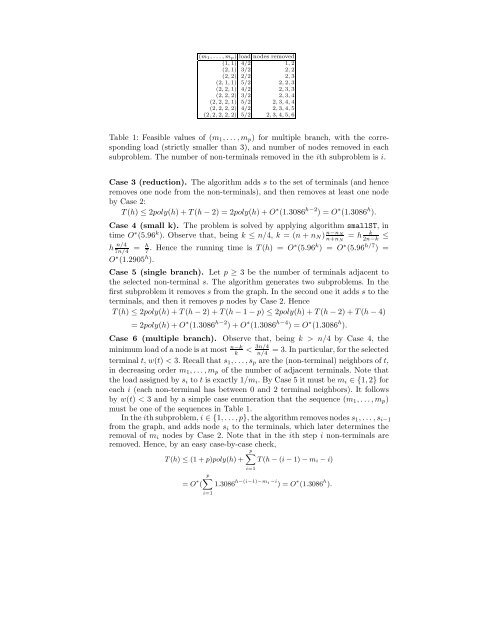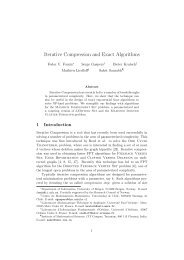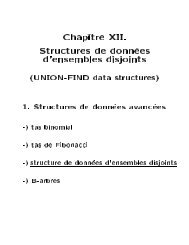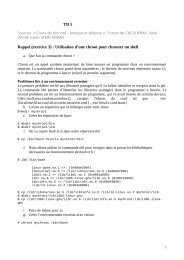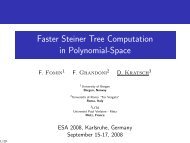Fast Steiner tree computation in polynomial space - Lita
Fast Steiner tree computation in polynomial space - Lita
Fast Steiner tree computation in polynomial space - Lita
You also want an ePaper? Increase the reach of your titles
YUMPU automatically turns print PDFs into web optimized ePapers that Google loves.
(m1,...,mp) load nodes removed<br />
(1, 1) 4/2 1, 2<br />
(2, 1) 3/2 2, 2<br />
(2, 2) 2/2 2, 3<br />
(2, 1, 1) 5/2 2, 2, 3<br />
(2, 2, 1) 4/2 2, 3, 3<br />
(2, 2, 2) 3/2 2, 3, 4<br />
(2, 2, 2, 1) 5/2 2, 3, 4, 4<br />
(2, 2, 2, 2) 4/2 2, 3, 4, 5<br />
(2, 2, 2, 2, 2) 5/2 2, 3, 4, 5, 6<br />
Table 1: Feasible values of (m1,...,mp) for multiple branch, with the correspond<strong>in</strong>g<br />
load (strictly smaller than 3), and number of nodes removed <strong>in</strong> each<br />
subproblem. The number of non-term<strong>in</strong>als removed <strong>in</strong> the ith subproblem is i.<br />
Case 3 (reduction). The algorithm adds s to the set of term<strong>in</strong>als (and hence<br />
removes one node from the non-term<strong>in</strong>als), and then removes at least one node<br />
by Case 2:<br />
T (h) ≤ 2poly(h)+T (h − 2) = 2poly(h)+O ∗ (1.3086 h−2 )=O ∗ (1.3086 h ).<br />
Case 4 (small k). The problem is solved by apply<strong>in</strong>g algorithm smallST, <strong>in</strong><br />
time O∗ (5.96k ). Observe that, be<strong>in</strong>g k ≤ n/4, k =(n + nN ) n−nN k = h n+nN 2n−k ≤<br />
h n/4 h<br />
7n/4 = 7 . Hence the runn<strong>in</strong>g time is T (h) = O∗ (5.96k ) = O∗ (5.96h/7 ) =<br />
O∗ (1.2905h ).<br />
Case 5 (s<strong>in</strong>gle branch). Let p ≥ 3 be the number of term<strong>in</strong>als adjacent to<br />
the selected non-term<strong>in</strong>al s. The algorithm generates two subproblems. In the<br />
first subproblem it removes s from the graph. In the second one it adds s to the<br />
term<strong>in</strong>als, and then it removes p nodes by Case 2. Hence<br />
T (h) ≤ 2poly(h)+T (h − 2) + T (h − 1 − p) ≤ 2poly(h)+T (h − 2) + T (h − 4)<br />
=2poly(h)+O ∗ (1.3086 h−2 )+O ∗ (1.3086 h−4 )=O ∗ (1.3086 h ).<br />
Case 6 (multiple branch). Observe that, be<strong>in</strong>g k > n/4byCase4,the<br />
m<strong>in</strong>imum load of a node is at most n−k 3n/4<br />
k < n/4 = 3. In particular, for the selected<br />
term<strong>in</strong>al t, w(t) < 3. Recall that s1,...,sp are the (non-term<strong>in</strong>al) neighbors of t,<br />
<strong>in</strong> decreas<strong>in</strong>g order m1,...,mp of the number of adjacent term<strong>in</strong>als. Note that<br />
the load assigned by si to t is exactly 1/mi. ByCase5itmustbemi∈{1, 2} for<br />
each i (each non-term<strong>in</strong>al has between 0 and 2 term<strong>in</strong>al neighbors). It follows<br />
by w(t) < 3 and by a simple case enumeration that the sequence (m1,...,mp)<br />
must be one of the sequences <strong>in</strong> Table 1.<br />
In the ith subproblem, i ∈{1,...,p}, the algorithm removes nodes s1,...,si−1<br />
from the graph, and adds node si to the term<strong>in</strong>als, which later determ<strong>in</strong>es the<br />
removal of mi nodes by Case 2. Note that <strong>in</strong> the ith step i non-term<strong>in</strong>als are<br />
removed. Hence, by an easy case-by-case check,<br />
p�<br />
T (h) ≤ (1 + p)poly(h)+ T (h − (i − 1) − mi − i)<br />
= O ∗ (<br />
i=1<br />
p�<br />
1.3086 h−(i−1)−mi −i ∗ h<br />
)=O (1.3086 ).<br />
i=1


